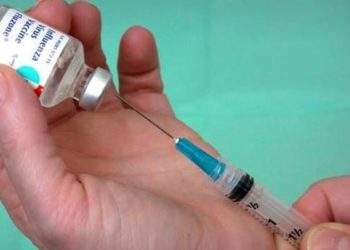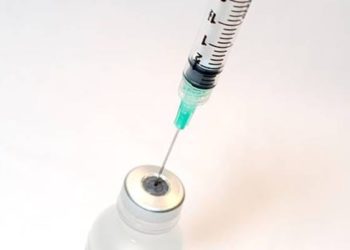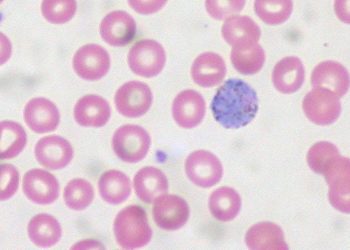Injectable loaded microparticle scaffolds improve vaccine responses in mice [PreClinical]
1. When injected into mice, long, thin mesoporous silica rods (MSRs) spontaneously formed scaffolds that recruited large numbers of cells to the empty spaces within the scaffold.
2. MSRs loaded with various immunostimulants released their cargo gradually, and increased recruitment of activated immune cells and sustained greater antibody production as compared with injection of the immunostimulants without MSRs.
Evidence Rating Level: 3 (Average)
Study Rundown: Recent explorations have aimed to evaluate the ability of vaccine-loaded biomaterials to elicit a more sustained immune response than achieved by the current administration technique of bolus injection. Previous investigations of bioscaffolds generally focused solely on in vitro studies, or required surgical implantation of a pre-manufactured biomaterial structure.
Researchers in this study developed a less invasive platform by injecting mice with MSRs, which, once injected, produced a nodule of a spontaneously formed 3D MSR scaffold structure. Upon excision, scaffolds were evaluated and found to contain millions of host immune cells. Researchers then investigated the ability of these structures to illicit a robust adaptive immune response by loading the MSRs with recruitment and immune-priming molecules. MSRs loaded with GM-CSF, a cytokine involved in dendritic cell recruitment, CpG-ODN, an immune cell activator, and the antigen ovalbumin (OVA) were injected into mice. Antibody levels, suggesting an adaptive immune response, remained higher in mice injected with MSRs loaded with all three components (MSR “vaccine”) than in mice injected with the immunostimulants alone. The enhanced immune response elicited by the vaccine-containing MSRs was maintained over time, and was similar to that of a bolus injection plus booster, suggesting MSR injections could eventually reduce the need for vaccine boosters. Finally, MSR vaccines given to mice subsequently injected with lymphoma cells caused a decrease in tumor size and an increase survival when compared to the bolus vaccine delivery.
The low invasiveness of this approach coupled with its potential to elicit a tunable and long-lasting immune response suggests it may be useful in preventing treatment-resistant diseases or treating life-threatening ones. Further characterization of the scaffold degradation in vivo and study advancement to large animals should highlight any negative side effects potentially associated with this novel approach.
Click to read the study in Nature Biotechnology
Relevant Reading: Mesoporous silica nanoparticles in biomedical applications
In-Depth [animal study]: Microscopy-based analysis showed that MSRs measured 88 x 45 µm in length x diameter. MSRs injected into the dorsal flanks of mice formed structures with pores large enough for cells to enter the scaffolds. In some experiments, scaffolds were excised and cells within the scaffold were analyzed. The quantities of cells expressing particular proteins were obtained through flow cytometry analysis using fluorescently-tagged dendritic cell markers. In both in vivo and in vitro experiments, MSRs were loaded with numerous combinations of GM-CSF, CpG-ODN, and OVA.
The nodule at the injection site began to shrink at 7 days post-injection, and virtually disappeared by day 25. The researchers used enzyme-linked immunosorbent assay (ELISA) in an in vitro system to show, after a quick burst release, CpG and GM-CSF slow release occurred (CpG, 90% released by day 7; GM-CSF, 66%% released by day 40). Imaging of in vivo fluorescently labeled OVA-loaded MSRs revealed OVA levels were higher in mice injected with OVA-loaded MSRs than with bolus OVA (p<0.05, n=4 per group), an effect that continued through day 10 post injection. The specific antibody levels evaluated after MSR vaccine injection were those of anti-OVA IgG2a and anti-OVA IgG1, which were measured as titers using ELISA. IgG2a levels were highest in the MSR vaccine group >200 days after injection (n=5 per group), and IgG1 levels were similar to the MSR+OVA group and higher than all other groups. Booster injection at day 30 resulted in higher titers of both antibodies (relative to pre-booster levels and to other condition post-booster levels) continuing after day 60 in the MSR vaccine group (n=5 per group).
A mouse lymphoma tumor study showed MSR vaccine delivery significantly reduced tumor size by day 30 in comparison to bolus vaccine delivery (p<0.05) and no vaccination (p<0.001). By day 30, 9/10 mice in the MSR vaccine group had survived, compared to 6/10 in the bolus vaccine group and 0/10 in the unvaccinated group.
More from this author: Nanoparticles may reduce impact of neurological injury, Cholesterol-containing lipid particles protect mice from lethal bacterial toxins, Noninvasive imaging method detects and evaluates size of metastases, Inhibition of key enzymes in the animal brain reduces drug relapse behavior
Image: PD/Wiki/US Navy
©2014 2 Minute Medicine, Inc. All rights reserved. No works may be reproduced without expressed written consent from 2 Minute Medicine, Inc. No article should be construed as medical advice and is not intended as such by the authors, editors, staff or by 2 Minute Medicine, Inc.







